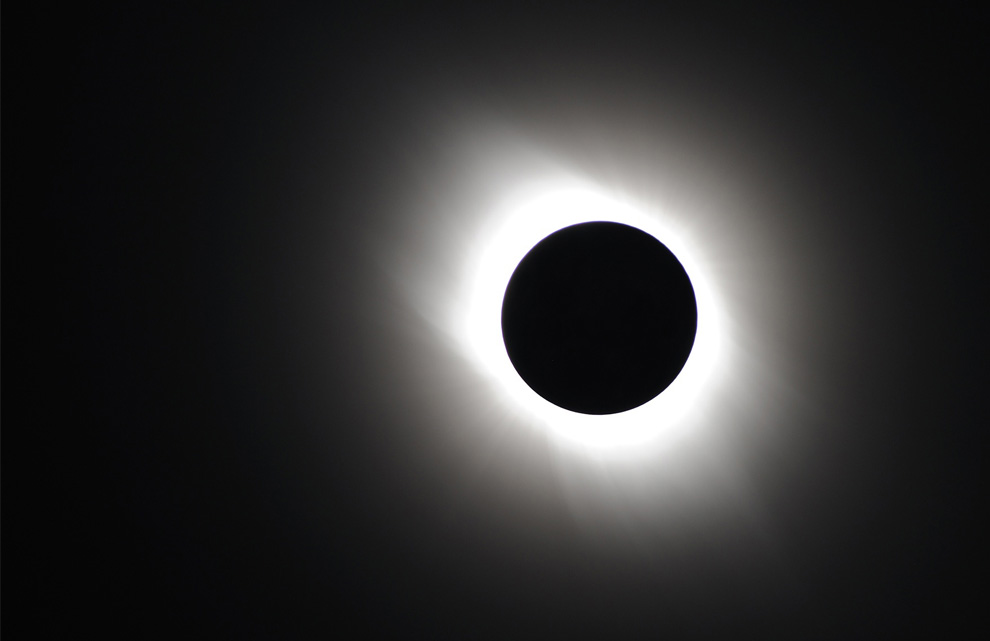BACKGROUND
The angular size of the Sun is a relatively easy constant to both explain and determine, which is fortunate, as it is vital in calculating the Astronomical Unit. Angular size in general is the angle occupied by (or, to use the technical term, subtended by) a given object in one's field of view--for instance, a person's pinky typically subtends about one degree when held at arm's length.
This is actually a reasonably good way of estimating the angular size, or any angular distance, such as altitude--the angle between the horizon and an object in the sky. However, since staring at the Sun is generally not a recipe for success, it's not recommended in this case. Fortunately, measuring the angular size of the Sun is not a terribly difficult process, particularly given the equipment at our disposal.
Definitely not to scale. However, the Moon does look a lot bigger than it really is--in reality it only subtends about half of a degree (Source)
This is actually a reasonably good way of estimating the angular size, or any angular distance, such as altitude--the angle between the horizon and an object in the sky. However, since staring at the Sun is generally not a recipe for success, it's not recommended in this case. Fortunately, measuring the angular size of the Sun is not a terribly difficult process, particularly given the equipment at our disposal.
EQUIPMENT AND OBSERVATIONS
The heliostat was once again the centerpiece of our observations, and we utilized it in much the same way as described here, with one critical and enormous difference: rather than focusing the Sun's image onto a piece of paper on a table, we focused it onto a piece of paper on an easel. Keeping the heliostat's tracking in operation, we again drew the outline of the Sun onto the easel, then disabled the tracking motor and allowed the Sun to drift. However, rather than watching for the movements of sunspots, we gauged the movement of the Sun's disc as a whole, recording the time it took for it to drift its width (so that its left side lined up with the original position of its right side). This process was performed and the time recorded twice; in both cases it was 00:02:14.
RESULTS AND CONCLUSIONS
Since the Sun moves through 360 degrees on the Earth's sky (approximately) every 24 hours, it was then possible to relate the time taken by the Sun to drift its width ($t_w$), divided by 24 hours, to its angular size ($a_{circledot}$), divided by 360 degrees, as shown below.\[\frac{t_w \: \: \textrm{seconds}}{24 \: \: \textrm{hours}} = \frac{a_{\odot} \: \: \textrm{degrees}}{360 \: \: \textrm{degrees}}\] We then converted 24 hours to seconds and solved for $a_{\odot}$. Since our two trials yielded the same $t_w$, both gave us the same $a_{\odot}$, .56 degrees. This holds up well under a sanity check, as the full Moon (for which one can use the pinky-measuring method) subtends about half a degree on the sky, and the angular size of the Moon and Sun are approximately the same.
Since the angular sizes of the Moon and Sun are so similar, it is possible for the Moon to exactly cover the Sun during a total solar eclipse (Source)
Error was certainly a factor in our observations, particularly given that we performed only two trials. It is difficult to say definitively whether or not our measured $t_w$ would have shown more variations given more measurements. If we were to repeat our observations, it would definitely be important to perform more trials. However, the check with the more directly measurable size of the Moon does lend confidence to our result. Furthermore, while the eccentricity of Earth's orbit does affect how large the Sun appears in our sky, it does so at a level more precise than that of our measurements, so it is possible to generalize our $a_{\odot}$ for the entire year.


Nice job Tom! Good discussion of the uncertainty in the measurement.
ReplyDelete